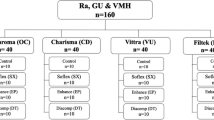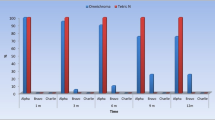Abstract
Purpose of Review
With the introduction of new resin-based composites (RBC) based on their adjusted shade properties, there is a need for an additional classification for such materials. This review discusses and suggests a new classification for the RBCs.
Recent Findings
The classification of RBCs depends on different compositions and characteristics such as inorganic filler type, shape and size, resin matrix, polymerization modes, level of viscosity, clinical application protocol, and indications. The classification is generally focused on the filler size, filler type, and composition. Recently, some manufacturers have created contemporary esthetic RBC kits with enhanced color adjustment potentials. This ability is considered very specific and particularly depends on the shade and the brand of the selected composite kit. The current RBC classifications are generally inadequate in describing the shade-matching abilities of these new materials.
Summary
An additional universal terminology and related classification are required, describing the level of color adjustment potential of contemporary RBCs. The suggested new classification divides RBCs as ‘polyshade,’ ‘simplyshade,’ and ‘monoshade universal.’


Similar content being viewed by others
References
Papers of particular interest, published recently, have been highlighted as: • Of importance •• Of major importance
• Zhou X, Huang X, Li M, Peng X, Wang S, Zhou X, Cheng L. Development and status of resin composite as dental restorative materials. J Appl Polym Sci. 2019;136(44):48180(1–12). This literature review presents the history and development of dental comoposites and addressing current restorative challanges facing dental composites during the clinical application.
Stein PS, Sullivan J, Haubenreich JE, Osborne PB. Composite resin in medicine and dentistry. J Long Term Eff Med implants. 2005;15(6):641–54.
Makvandi P, Jamaledin R, Jabbari M, Nikfarjam N, Borzacchiello A. Antibacterial quaternary ammonium compounds in dental materials: a systematic review. Dent Mater. 2018;34:851–67.
Ferracane JL. Resin-based composite performance: are there some things we can’t predict? Dent Mater. 2013;29(1):51–8.
Rebholz-Zaribaf N, Özcan M. Adhesion to zirconia as a function of primers/silane coupling agents, luting cement types, aging and test methods. J Adhes Sci Technol. 2017;31(13):1408–21.
Santini A, Gallegos IT, Felix CM. Photoinitiators in dentistry: a review. Prim Dent J. 2013;2(4):30–3.
Ilie N. Comparison of modern light-curing hybrid resin-based composites to the tooth structure: static and dynamic mechanical parameters. J Biomed Mater Res. 2022;110:2121–32.
Randolph LD, Palin WM, Leloup G, Leprince JG. Filler characteristics of modern dental resin composites and their influence on physico-mechanical properties. Dent Mater. 2016;32(12):1586–99.
Randolph LD, Palin WM, Leprince JG. Developing a more appropriate classification system for modern resin-based composite technologies. In: Miletic V (ed) Dental composite materials for direct restorations. Springer: Cham. 2018; pp. 89–96.
Lü Q, Guo F, Sun L, Li A, Zhao L. Surface modification of ZrO2: Er3+ nanoparticles to attenuate aggregation and enhance upconversion fluorescence. J Phys Chem. 2008;112(8):2836–44.
Lutz F, Phillips RW. A classification and evaluation of composite resin systems. J Prosthet Dent. 1983;50(4):480–8.
Bayn SC, Heymann HO, Swift EJ Jr. Update on dental composite restorations. J Am Dent Assoc. 1994;125(6):687–701.
Heintze SD, Rousson V, Hickel R. Clinical effectiveness of direct anterior restorations—a meta-analysis. Dent Mater. 2015;31(5):481–95.
Ferracane JL. Resin composite-state of the art. Dent Mater. 2011;27(1):29–38.
Kim KH, Ong JL, Okuno O. The effect of filler loading and morphology on the mechanical properties of contemporary composites. J Prosthet Dent. 2002;87(6):642–9.
Miletic V. Development of dental composites. In: Miletic V (ed) Dental composite materials for direct restorations. Springer: Cham. 2018; pp. 3–9.
German MJ. Developments in resin-based composites. British Dent J. 2022;232(9):638–43.
Zhou X, Huang X, Li M, Peng X, Wang S, Zhou X, Cheng L. Development and status of resin composite as dental restorative materials. J Appl Polym Sci. 2019;136(44):48180(1-12).
Maghaireh GA, Taha NA, Alzraikat H. The silorane-based resin composites: a review. Oper Dent. 2017;42(1):24–34.
Alzraikat H, Burrow MF, Maghaireh GA, Taha NA. Nanofilled resin composite properties and clinical performance: a review. Oper Dent. 2018;43(4):173–90.
Kavuncu G, Yilmaz AM, Karademir Yilmaz BK, Atali PY, Altunok EC, Kuru L, Agrali OB. Cytotoxicity of different nano composite resins on human gingival and periodontal ligament fibroblast cell lines: an in vitro study. Biomed. 2020;8(3):48.
Ilie N, Stawarczyk B. Evaluation of modern bioactive restoratives for bulk-fill placement. J Dent. 2016;49:46–53.
Tsujimoto A, Barkmeier WW, Takamizawa T, Latta MA, Miyazaki M. Depth of cure, flexural properties and volumetric shrinkage of low and high viscosity bulk-fill giomers and resin composites. Dent Mater J. 2017;36(2):205–13.
Neto C, das Neves AM, Arantes DC, Sa T, Yamauti M, de Magalhaes CS, Abreu LG, Moreira AN. Evaluation of the clinical performance of GIOMERs and comparison with other conventional restorative materials in permanent teeth: a systematic review and meta analysis. Evid Based Dent. 2022; pp. 1–10.
Kwon TY, Bagheri R, Kim YK, Kim KH, Burrow MF. Cure mechanisms in materials for use in esthetic dentistry. J Investig Clin Dent. 2012;3:3–16.
Leprince JG, Palin WM, Hadis MA, Devaux J, Leloup G. Progress in dimethacrylate-based dental composite technology and curing efficiency. Dent Mater. 2013;29(2):139–56.
Lee YK, Yu B, Lim HN, Lim JI. Difference in the color stability of direct and indirect resin composites. J Appl Oral Sci. 2011;19:154–60.
Leinfelder KF. Indirect posterior composite resins. Compend Contin Educa Dent. 2005;26(7):495–503.
Baldi A, Scattina A, Ferrero G, Comba A, Alovisi M, Pasqualini D, Scotti N. Highly-filled flowable composite in deep margin elevation: FEA study obtained from a microCT real model. Dent Mater. 2022;38(4):94–107.
Oz FD, Ozturk C, Soleimani R, Gurgan S. Sixty-month follow up of three different universal adhesives used with a highly-filled flowable resin composite in the restoration of non-carious cervical lesion. Clin Oral Investig. 2022;26:5377–87.
Kantovitz KR, Pascon FM, Nobre-dos-Santos M, Puppin-Rontani RM. Review of the effects of infiltrants and sealers on non-cavitated enamel lesions. Oral Health Prev Dent. 2010;8(3):295–305.
Kim HK, Kim SH. Effect of the number of coloring liquid applications on the optical properties of monolithic zirconia. Dent Mater. 2014;30(9):229–37.
Poitevin A, De Munck J, Van Ende A, Suyama Y, Mine A, Peumans M, Van Meerbeek B. Bonding effectiveness of self-adhesive composites to dentin and enamel. Dent Mater. 2013;29(2):221–30.
de Oliveira DC, Rovaris K, Hass V, Souza-Júnior EJ, Haiter-Neto F, Sinhoreti MA. Effect of low shrinkage monomers on physicochemical properties of dental resin composites. Braz Dent J. 2015;26(3):272–6.
Hall NR, Kafalias MC. Composite colour matching: the development and evaluation of a restorative colour matching system. Aust Prosthodont J. 1991;5:47–52.
Paravina RD, Westland S, Imai FH, Kimura M, Powers JM. Evaluation of blending effect of composites related to restoration size. Dent Mater. 2006;22(4):299–307.
• Paravina RD, Westland S, Johnston WM, Powers JM. Color adjustment potential of resin composites. J Dent Res. 2008;87(5):499–503. This in vitro study defines the most recently accepted ‘color adjustment potential’ term instead of blending effect and chameleon effect for the first time.
•• Paravina RD, Westland S, Kimura M, Powers JM, Imai FH. Color interaction of dental materials: blending effect of layered composites. Dent Mater. 2006;22(10):903–8. This in vitro study presents the color adjustment potentials of layered resin composites and discussed the relations among the material type, shade, blending effect and level of translucency.
Lee YK, Yu B, Zhao GF, Lim JI. Color assimilation of resin composites with adjacent color according to the distance. J Esthet Restor Dent. 2015;27(1):24–32.
Tsubone M, Nakajima M, Hosaka K, Foxton RM, Tagami J. Color shifting at the border of resin composite restorations in human tooth cavity. Dent Mater. 2012;28(8):811–7.
Kano Y, Nakajima M, Aida A, Seki N, Foxton RM, Tagami J. Influence of enamel prism orientations on color shifting at the border of resin composite restorations. Dent Mater J. 2018;37(2):341–9.
Suh YR, Ahn JS, Ju SW, Kim KM. Influences of filler content and size on the color adjustment potential of nonlayered resin composites. Dent Mater J. 2017;36(1):35–40.
Hatayama T, Kano Y, Aida A, Chiba A, Sato K, Seki N, Hosaka K, Foxton RM, Tagami J, Nakijima M. The combined effect of light- illuminating direction and enamel rod orientation on color adjustment at the enamel borders of composite restorations. Clin Oral Investig. 2019;24:2305–13.
Pereira Sanchez N, Powers JM, Paravina RD. Instrumental and visual evaluation of the color adjustment potential of resin composites. J Esthet Restor Dent. 2019;31:465–70.
Durand LB, Ruiz-Lopez J, Perez BG, et al. Color, lightness, chroma, hue, and translucency adjustment potential of resin composites using CIEDE2000 color difference formula. J Esthet Restor Dent. 2021;33(6):836–43.
Trifkovic B, Powers JM, Paravina RD. Color adjustment potential of resin composites. Clin Oral Investig. 2017;22:1601–7.
•• Ismail EH, Paravina RD. Color adjustment potential of resin composites: optical illusion or physical reality, a comprehensive overview. J Esthet Restor Dent. 2022;34(1):42–54. This comprehensive literature review presents the optical properties of current resin-based dental composites and dicusses the clinical advantages of composites with enhanced optical properties.
• Ilie N. Universal chromatic resin-based composites: aging behavior quantified by quasi-static and viscoelastic behavior analysis. Bioengineering. 2022;9(7):270. This in vitro study discusses the aging behaviour of the universal chromatic resin-based composited.
Dietschi D, Fahl N Jr. Shading concepts and layering techniques to master direct anterior composite restorations: an update. Br Dent J. 2016;221(12):765–71.
Lowe RA. OMNICHROMA: one composite that covers all shades for an anterior tooth. Compend Contin Educ Dent. 2019;40(1):8–10.
Yoshioka S, Kinoshita S. Structural or pigmentary? Origin of the distinctive white stripe on the blue wing of a Morpho butterfly. Proc Royal Soc B: Biol Sci. 2006;273(1583):129–34.
Chung K, Yu S, Heo CJ, et al. Flexible, angle-independent, structural color reflectors inspired by morpho butterfly wings. Adv Mater. 2012;24(18):2375–9.
• de Abreu JLB, Sampaio CS, Benalcazar Jalkh EB, Hirata R. Analysis of the color matching of universal resin composites in anterior restorations. J Esthet Restor Dent. 2021;33(2):269–76. This in vitro study assesses the level of color matching ability for the universal resin composites in anterior restorations on denture central incisors.
Korkut B. Selection of resin composite. In: Korkut B (ed) Composite restorations in anterior esthetics. Quintessence Publishing. 2022; pp. 73–137.
Author information
Authors and Affiliations
Corresponding author
Ethics declarations
The Section Editors for the topical collection Dental Restorative Materials are Mutlu Özcan and Paulo Francisco Cesar. Please note that Section Editor Mutlu Özcan was not involved in the editorial process of this article as she is a co-author.
Conflict of Interest
The authors declare no competing interests.
Human and Animal Rights and Informed Consent
No animal or human subjects by the authors were used in this study.
Additional information
Publisher's Note
Springer Nature remains neutral with regard to jurisdictional claims in published maps and institutional affiliations.
Rights and permissions
Springer Nature or its licensor (e.g. a society or other partner) holds exclusive rights to this article under a publishing agreement with the author(s) or other rightsholder(s); author self-archiving of the accepted manuscript version of this article is solely governed by the terms of such publishing agreement and applicable law.
About this article
Cite this article
Korkut, B., Tarçın, B., Atalı, P.Y. et al. Introduction of a New Classification for Resin Composites with Enhanced Color Adjustment Potential. Curr Oral Health Rep 10, 223–232 (2023). https://doi.org/10.1007/s40496-023-00351-2
Accepted:
Published:
Issue Date:
DOI: https://doi.org/10.1007/s40496-023-00351-2




